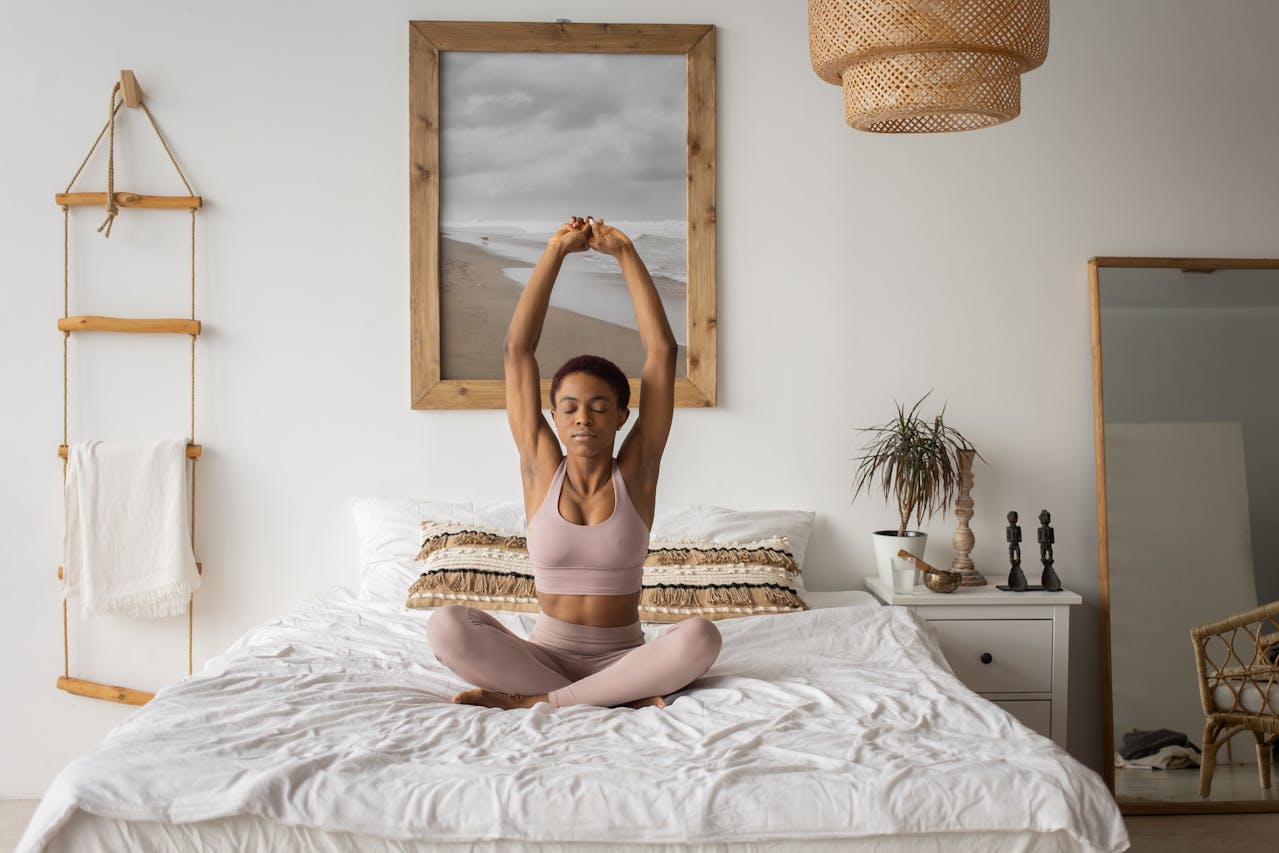
Table of Contents
Yoga Nidra is a guided meditation that promotes deep relaxation and strengthens the mind-body connection.
What is Yoga Nidra?
Renowned yoga teacher and guru Swami Satyananda Saraswati perfectly answers the “What is Yoga Nidra?” question by referring to it as “reaching the border between waking and sleeping states.”

To prepare for the guided meditation, the practitioner will lie down, either on the floor on a mat or on a bed. It will begin with breath awareness exercises to slow the heart rate before moving into more complex Yoga Nidra exercises.
Yoga Nidra offers a wide range of benefits and can even be used as a treatment for numerous conditions by bringing the body to a healing state. One of the most notable benefits of this restorative practice is enhancing and regulating the sleep cycle. Guided meditation can improve sleep habits through regular usage, help people rest more soundly, fall asleep faster, and reach a deeper resting state. The results will enhance one's inner peace and improve their quality of life.
Yoga Nidra is also used as a treatment for sleep-related issues, including chronic insomnia. Read our article on Yoga Nidra Benefits to learn more about the potential benefits.
Ten Vital Reasons a Healthy Sleep Cycle Is Essential
- Resting is crucial for a healthy immune system. People who sleep less than seven hours a night are three times more likely to develop a cold than those who rest eight hours or more.
- People who sleep well eat fewer calories. Those who are sleep-deprived tend to have an increased appetite because their daily fluctuation of appetite hormones is disrupted.
- Poor sleepers have a greater risk of heart disease and stroke. Sleep deprivation is a driver in many chronic diseases, demonstrating why adults must get enough rest.
- Quality sleep can maximize athletic performance. A good night's rest can improve speed, accuracy, mental wellbeing, and reaction time.
- Poor sleep is linked to inflammation. Not getting enough sleep at night can activate inflammation and cell damage markers. In addition, sleep deprivation is linked to inflammation of the digestive system, which causes inflammatory bowel disease (IBS).
- Sleep affects emotions and reduces your ability to interact socially. A poor sleep cycle makes it more difficult for you to recognize and respond to social cues and process emotional information.
- Inadequate sleep is linked to higher body weight. Sleep deprivation is one of the most significant risk factors for obesity.
- Quality sleep improves productivity, concentration, and overall cognitive performance. One study found that a lack of sleep impacts brain functions similarly to alcohol.
- Sleep affects glucose metabolism and type 2 diabetes risk. Restricting your daily rest affects blood sugar and reduces sensitivity to insulin, which can cause prediabetes in healthy adults in as little as six days.
- A lack of sleep is linked to depression and other mental health issues. For example, an estimated 90% of people with depression complain about their sleep quality. In addition, People with sleeping disorders, such as insomnia, report significantly higher rates of depression than those without.
How Does Yoga Nidra Help People Get Enough Sleep?
The translation of the word Nidra actually means sleep. Yoga Nidra for sleep is a practice that promotes a deep level of awareness and relaxation, which can help to refine your resting patterns and improve the sleep quality of a person. It can do this because, as Kamini Desai states in his book Yoga Nidra: The Art of Transformational Sleep:
“[Yoga Nidra] is structured to drop the mind down toward sleep to deliberately enter a state where the mind is naturally silent and still […] Yoga Nidra is a unique meditative practice because it rides on the natural process of sleep, which is already built into our system. Sleep is not something we have to learn. Our body already knows how to do it. Ancient Yogis realized they could follow the same route, descending down into sleep states to consciously release identification with thoughts.”
When Desai says, “identification with thoughts,” he refers to Yoga Nidra's ability to create new thinking patterns. The guided meditation allows us to think about our thinking from a new perspective. This helps us rewire some of our thought patterns that stand in the way of our joy and wellbeing while.
Here, we can reject bad habits of old, harmful thinking patterns and ignite better and more positive perspectives on how we feel and what we think about. This reduces worry, stress, and anxiety, and allows people to sleep better by reducing rumination. That is the process of thinking about the same thoughts, which tend to be dark. Unfortunately, this keeps millions of Americans from getting enough sleep each night. It is dangerous to one's mental health and can impair their ability to process emotions.
Through dedicated Yoga Nidra practice, people can put an end to rumination thinking and improve their sleep quality.
Yoga Nidra for sleep is one of the most accessible and effective yogic practices that can get you feeling relaxed. It promotes inner peace and releases tension and anxiety. This sleep meditation is a scientifically proven method to improve this aspect of your health and wellness. If you have been struggling to attain quality sleep at night, practice Yoga Nidra.
Disclaimer
As with any type of exercise, yoga does not come without its own risks. Practicing yoga should be done with care and respect, reducing the risk of injury.
If you are suffering from any medical conditions or are unsure which type of yoga or exercise is best suited for you and your conditions, we advise you to consult a medical professional or your doctor.
Frequently Asked Questions
Can I do Yoga Nidra before sleep?
Yes, you can perform a Yoga Nidra session at any time of day, including in the morning or before bed. Practicing Yoga Nidra is beneficial for those who have trouble falling asleep or wake up in the middle of the night and have difficulty getting back to sleep. If your goal is to use Yoga Nidra for sleep improvement, performing the practice in the evening is actually very beneficial. It can help you reach a deeper state of sleep for a longer duration.
When you perform the exercise at night, you can be part of the conscious mind as you deactivate. After this, you may fall asleep due to your tired state. Relaxing the body and brain before bedtime will thoroughly prepare the whole body for rest. Although the practitioner is awake and conscious for the exercise duration, the meditation will have them feeling relaxed and ready for bed in no time. For best results, practice Yoga Nidra regularly.
Can Yoga Nidra replace sleep?
Sleep meditation can be very beneficial. However, it cannot replace sleep. Yoga Nidra for sleep may help you feel well-rested after a shorter duration and allow you to access a deeper state of relaxation, but it does not provide all of the same benefits as sleep. Quality sleep is needed to rejuvenate us. It is critical for certain health aspects, including our skin health and wellbeing. Sleep meditation allows us to explore consciousness from a calm and receptive position that can be used to prepare us for sleep - not replace it.
Is Yoga Nidra better than sleep?
 Yoga Nidra is a state of conscious sleep, where your whole body rests and your brain remains aware. This allows your entire body, mind, and nervous system to relax fully. When the state of deep relaxation is achieved, the benefits of this yogic practice can be seen as superior to ordinary rest.
Yoga Nidra is a state of conscious sleep, where your whole body rests and your brain remains aware. This allows your entire body, mind, and nervous system to relax fully. When the state of deep relaxation is achieved, the benefits of this yogic practice can be seen as superior to ordinary rest.
Research shows that one hour of Yoga Nidra can be equivalent to a few hours of sleep. However, Yoga Nidra is not a substitute for sleep, and both are needed to attain greater wellbeing. Instead of taking a midday nap to relax your mind, try substituting this with a 30-minute session of Yoga Nidra.
References
Dharma Mittra Answers Readers' Yoga Nidra FAQs
10 Top Benefits of Getting More Sleep
Six Beliefs About Yoga Nidra Debunked – Nolla pelli
Disclaimer
The contents of this article are provided for informational purposes only and are not intended to substitute for professional medical advice, diagnosis, or treatment. It is always recommended to consult with a qualified healthcare provider before making any health-related changes or if you have any questions or concerns about your health. Anahana is not liable for any errors, omissions, or consequences that may occur from using the information provided.

By: Anahana
The Anahana team of researchers, writers, topic experts, and computer scientists come together worldwide to create educational and practical wellbeing articles, courses, and technology. Experienced professionals in mental and physical health, meditation, yoga, pilates, and many other fields collaborate to make complex topics easy to understand. Anahana is also home to specialists in crystals, tarot, angel numbers, astrology, life path numbers, zodiac signs, and horoscopes. By combining evidence-based wellness with spiritual and energetic practices, the team offers clear, trustworthy guidance for both mind-body health and modern spirituality.